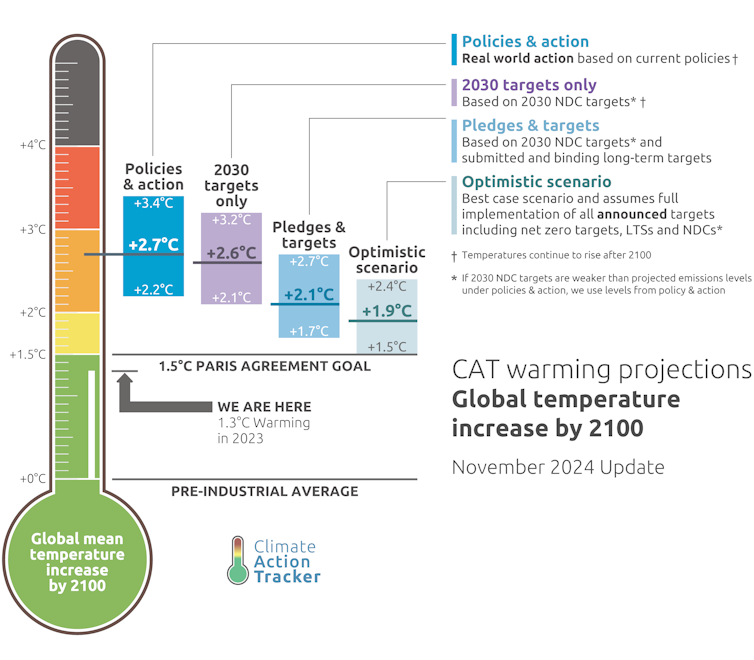What we’re seeing is a removing of cooling that’s revealing warming that’s already there. So the air pollution isn’t the cause of the warming. It’s just letting us see stuff that we’ve already done.Listen to the interview on The Conversation Weekly podcast. You can also read an article by Laura Wilcox and her colleague Bjørn H. Samset about their recent research on The Conversation. This episode of The Conversation Weekly was written and produced by Mend Mariwany, Gemma Ware and Katie Flood. Mixing by Michelle Macklem and theme music by Neeta Sarl. Newsclips in this episode from Voice of America, CBC, AP Archive, ABC (News) Australia, WFLA NBC Channel 8 and PBS. Listen to The Conversation Weekly via any of the apps listed above, download it directly via our RSS feed or find out how else to listen here. A transcript of this episode is available via the Apple Podcasts or Spotify apps.
News
UN climate negotiations end on shaky geopolitical ground, but I see reasons for hope

Shannon Gibson, USC Dornsife College of Letters, Arts and Sciences
The 2024 United Nations climate talks wrapped up two days late, with an ending fitting that of a geopolitical reality TV show, complete with walkouts and recriminations.
Countries agreed on a new climate finance target on Nov. 24, 2024, promising to provide at least US$300 billion annually by 2035 to help developing countries build clean energy systems. But it was far less than the $1.3 trillion vulnerable countries were calling for.
The conference also delayed a debate over how to move forward on a 2023 agreement for all countries to contribute to “transitioning away from fossil fuels” and to submit climate pledges aligned with the 1.5C limit.
Some people may be ready to write the epitaph for global progress against climate change. But as someone who teaches global environmental politics and has followed international climate talks for years, I see both practical and moral reasons to remain hopeful.
The battle to keep the 1.5 C goal alive
In 2015, the world’s nations agreed as part of the Paris climate accord to limit global warming to 2 degrees Celsius (3.6 degrees Fahrenheit), with an aspirational target of 1.5 C (2.7 F). This target is important, but sometimes confusing. It is rooted in science, but it is not a singular “tipping point.”
As the planet warms beyond 1.5 C, multiple large-scale climate shifts will become more likely.
Ocean circulation is already slowing, coral reefs face increasingly common mass bleaching events as the oceans heat up, and Arctic permafrost is thawing, releasing greenhouse gases that further fuel climate change. Rising temperatures are also fueling increasingly frequent and more damaging heat waves, droughts, wildfires and flooding that put human lives and livelihoods at risk.
https://datawrapper.dwcdn.net/mRX0t/1
Recognizing these risks, the Paris Agreement was widely heralded, and many countries have made progress in lowering their emissions in the decade since. However, not all countries are pulling their weight.
In 2023, the U.N. acknowledged that the countries’ current commitments for addressing climate change, known as nationally determined contributions, or NDCs, would still result in a catastrophic 2.5 C to 2.9 C (4.5 F to 5.2 F) of warming by 2100.
The World Meteorological Organization issued a “red alert” in November 2024 that the world is on track to overshoot the 1.5 C goal this year. It notes that this overshoot can be temporary – if countries take greater action.
How the world can still meet the Paris goals
Countries can still turn the tide on climate change.
The outcomes of the 2023 climate talks provided a road map for countries to increase their efforts toward net-zero emissions:
- Triple renewable energy capacity globally.
- Accelerate a phasedown of coal power.
- Transition away from fossil fuels.
- Accelerate zero-emissions and low-emissions technologies.
- Cut methane and other noncarbon dioxide emissions.
- Reduce emissions from road transport.
- Phase out inefficient fossil fuel subsidies.
Many countries are making progress on this transition.
Among developed countries, Norway is on track to phase out of fossil fuel vehicle sales in 2025. China has become a leader in renewable energy. It pledged in 2020 to double its renewable energy capacity by 2030, and, thanks to solar power deployment, it expects to complete that goal in half the time.
Other nations, including the U.K., Greece and Denmark, have embarked on major efforts to scale down coal power, with Portugal being the first to hit zero coal.
An important mechanism of the Paris Agreement is the expectation that countries will ratchet up their commitments every five years. The deadline for these new climate goals is early 2025, and some countries have gotten a head start.
Brazil announced its new climate commitments during the climate conference, pledging to reduce emissions 67% by 2035. The United Arab Emirates submitted a commitment to reduce its emissions by 47% compared with its 2019 baseline emissions. Other countries signaled their intentions in high-level statements. Belgium announced a doubling of its climate finance contribution.
These new announcements are a good sign of continued global support for the Paris Agreement goals.
Additionally, the conference made progress on agreements to reduce non-CO₂ emissions, namely methane, nitrous oxide and hydrofluorocarbons – also known as climate change “super pollutants” because of their extreme global warming potential.
Why the Paris Agreement will survive a second Trump presidency
There is no doubt that Donald Trump returning as U.S. president will pose significant roadblocks to efforts to slow climate change. As a candidate, he talked about throttling back U.S. efforts, including cutting funding for clean energy and eliminating regulations on the fossil fuel industry.
But efforts to deal with climate change are bigger than one person or even one country.
While Trump has declared that he will pull the U.S. out of the international Paris Agreement again, influential people are advising him to reconsider. Exxon Mobil CEO Darren Woods argued that a U.S. withdrawal would leave a hole at the global negotiating table.
Even if Trump does pull the U.S. out of the treaty, which he can do after a one-year waiting period, that doesn’t mean pro-climate actions in the U.S. will simply stop or that the agreement will fall apart.
There are commonsense business reasons to push climate efforts forward, starting with the fact that clean energy is now cheaper than fossil fuels in much of the world. Nearly 1 in 5 vehicles sold in 2023 globally were electric. In the U.S., heat pump sales are beating gas furnaces for the third straight year. https://ourworldindata.org/grapher/levelized-cost-of-energy?tab=chart
A withdrawal from the Paris Agreement also does not prevent states and cities from continuing their progress against climate change.
In fact, after Trump announced he would withdraw the U.S. from the agreement in 2017, several U.S. states doubled down on their climate commitments. Hawaii, for example, passed legislation to be “Paris compliant” and get to net-negative emissions, meaning it will sequester more emissions than it emits.
California continues to report falling emissions even with a growing economy. The state sued several large oil and gas companies for deceiving the public about climate change.
Moreover, a U.S. retreat from the Paris Agreement would not be an embargo on individual actions. Engineers and scientists will continue to create innovative technology to reduce emissions and slow climate change, and corporations will reap the economic benefits of energy efficiency and clean energy market leadership.
This acknowledgment has given rise to calls for a blend of optimism and pragmatism.
Looking ahead to 2025
Next year’s COP30, to be held in Brazil, is important because countries face a deadline for setting new targets. Overall, their current policies still fall short of the 1.5 C goal.
Calls for greater commitments are not just optimistic, they are economically and morally compelling.
For one, the future cost of inaction now is greater than the cost of action, so concerted decisions to delay emissions cuts now will only harm countries in the future.
Morally, the international community has a responsibility to mitigate suffering. This is the very nature of long-held international norms and laws, such as the “responsibility to protect,” and reiterated in Pope Francis’ calls for global environmental responsibility.
While the climate will breach the 1.5 C warming limit, every fraction of a degree matters. I believe it is crucial that countries, states, business leaders and people everywhere continue the shift toward cleaner energy to minimize the impact.
Researchers Emerson Damiano and Lauren Segal, students in environmental studies at the University of Southern California, contributed to this article.
Shannon Gibson, Associate Professor of International Relations and Environmental Studies, USC Dornsife College of Letters, Arts and Sciences
This article is republished from The Conversation under a Creative Commons license. Read the original article.
STM Daily News is a vibrant news blog dedicated to sharing the brighter side of human experiences. Emphasizing positive, uplifting stories, the site focuses on delivering inspiring, informative, and well-researched content. With a commitment to accurate, fair, and responsible journalism, STM Daily News aims to foster a community of readers passionate about positive change and engaged in meaningful conversations. Join the movement and explore stories that celebrate the positive impacts shaping our world.
Discover more from Daily News
Subscribe to get the latest posts sent to your email.
Blog
DoorDash Driver Arrested After Claiming Sexual Assault: What Really Happened?
A DoorDash driver who claimed she was sexually assaulted during a delivery is now facing felony charges after police say her viral video showed an unconscious, partially nude customer without consent. Here’s what investigators found and why the case is sparking national debate.
Last Updated on December 3, 2025 by Daily News Staff
DoorDash delivery driver involved in a viral video controversy after claiming sexual assault; police say no assault occurred, and the driver now faces felony charges.
DoorDash Driver Arrested After Claiming Sexual Assault: What Really Happened?
A Viral Accusation Turns Into a Criminal Case
A routine food drop-off turned into a national controversy this month after a DoorDash delivery driver claimed she was sexually assaulted during a delivery — only to later be arrested herself following a police investigation. The incident, which quickly spread across TikTok and other platforms, has generated fierce debate over privacy, personal safety, and the power of viral video culture.
The driver, identified as Livie Rose Henderson, posted a video on social media in mid-October claiming that when she arrived at a customer’s home in Oswego, New York, she found the front door open and discovered a man “half-naked and unconscious” on his couch. She publicly described the moment as a sexual assault, saying she felt endangered and traumatized.
Her posts went viral almost immediately, drawing attention from millions of viewers and sparking outrage over the safety risks faced by gig workers — particularly women — who make deliveries to unfamiliar homes.
But the narrative took a dramatic turn.
Police: No Sexual Assault Occurred
According to the Oswego Police Department, an investigation found no evidence that Henderson was sexually assaulted. Instead, authorities say that she:
Entered the home without consent
Recorded the unconscious customer, who was partially nude
Posted the footage online, identifying him
Made claims police say were “false and misleading”
Investigators concluded the man was intoxicated and unconscious, not acting with intent or awareness. As a result, Henderson was arrested and charged with:
Second-degree unlawful surveillance (felony)
First-degree dissemination of unlawful surveillance images (felony)
Police emphasized that recording a person who is nude or partially nude inside their home — regardless of context — constitutes a violation of New York’s surveillance and privacy laws if done without permission.
DoorDash Drops the Driver
Henderson also claimed that DoorDash deactivated her account, something she described as retaliation for “exposing her assaulter.” But following her arrest, DoorDash stated that recording customers inside their homes violates company policy and local laws.
DoorDash said it cooperated with investigators but declined to comment further on personnel matters.
A Complicated Public Reaction
Social media reaction has been sharply divided:
Sympathy for the driver
Many viewers initially supported Henderson, arguing that gig workers often deal with unsafe conditions and should not be forced to decide between finishing a delivery or backing away from a potentially threatening situation.
Backlash over privacy violations
Others argue that Henderson crossed legal and ethical boundaries by:
Entering a private residence
Recording a vulnerable, unconscious person
Posting it publicly
Accusing the individual of a crime without evidence
These actions, critics say, show the dangerous consequences of rushing to social media before police or professional investigators evaluate the facts.
The Larger Issue: Safety vs. Responsibility
This case highlights a broader tension in the era of app-based work and viral content:
Gig workers do indeed face unpredictable and sometimes unsafe situations.
Customers have a right to privacy in their homes.
Social media, meanwhile, rewards the fastest and most dramatic version of a story — even before the truth is known.
As the criminal process continues, Henderson’s case may set a new precedent for how privacy laws interact with the realities of delivery work and the instant visibility of online platforms.
Further Reading
DoorDash driver fired for sharing video of customer, claims sexual assault – Newsweek
Covers the viral video incident and how the driver’s DoorDash account was deactivated after she claimed sexual assault.
Details the police investigation and the subsequent charges filed against the driver.
The Viral ‘DoorDash Girl’ Saga Unearthed a Nightmare for Black Creators – Wired
Analyzes the social media fallout, the viral spread of the video, and the broader implications for gig workers and online creators.
Breaks down the conflicting narratives and public reactions to Henderson’s claims and the viral video.
DoorDash driver charged after recording, posting video of nude customer – WBTV
Official police statement on the investigation and the charges against Henderson.
Doordasher arrested over TikTok of half-naked customer – Law Enforcement Today
Focuses on the legal perspective, privacy violations, and the potential consequences of posting sensitive content online.
STM Daily News is a vibrant news blog dedicated to sharing the brighter side of human experiences. Emphasizing positive, uplifting stories, the site focuses on delivering inspiring, informative, and well-researched content. With a commitment to accurate, fair, and responsible journalism, STM Daily News aims to foster a community of readers passionate about positive change and engaged in meaningful conversations. Join the movement and explore stories that celebrate the positive impacts shaping our world.
Discover more from Daily News
Subscribe to get the latest posts sent to your email.
podcasts
How China cleaned up its air pollution – and what that meant for the climate
How China cleaned up its air pollution: Beijing’s air quality went from hazardous to good while Delhi and Lahore still struggle. Discover how China dramatically reduced pollution since 2013—and why cleaner air may have unintended consequences for global warming and climate change.
How China cleaned up its air pollution – and what that meant for the climate
Dive into “The Knowledge,” where curiosity meets clarity. This playlist, in collaboration with STMDailyNews.com, is designed for viewers who value historical accuracy and insightful learning. Our short videos, ranging from 30 seconds to a minute and a half, make complex subjects easy to grasp in no time. Covering everything from historical events to contemporary processes and entertainment, “The Knowledge” bridges the past with the present. In a world where information is abundant yet often misused, our series aims to guide you through the noise, preserving vital knowledge and truths that shape our lives today. Perfect for curious minds eager to discover the ‘why’ and ‘how’ of everything around us. Subscribe and join in as we explore the facts that matter. https://stmdailynews.com/the-knowledge/
Discover more from Daily News
Subscribe to get the latest posts sent to your email.
News
The Hong Kong high-rise fire shows how difficult it is to evacuate in an emergency
Hong Kong High-Rise Fire: The deadly Hong Kong fire exposes critical challenges in evacuating tall buildings. Learn why stair descent is slower than expected, how human behavior causes delays, and what modern safety features can save lives.

The Hong Kong high-rise fire shows how difficult it is to evacuate in an emergency
Milad Haghani, The University of Melbourne; Erica Kuligowski, RMIT University, and Ruggiero Lovreglio, Te Kunenga ki Pūrehuroa – Massey University The Hong Kong high-rise fire, which spread across multiple buildings in a large residential complex, has killed dozens, with hundreds reported missing. The confirmed death toll is now 44, with close to 300 people still unaccounted for and dozens in hospital with serious injuries. This makes it one of Hong Kong’s deadliest building fires in living memory, and already the worst since the Garley Building fire in 1996. Although more than 900 people have been reportedly evacuated from the Wang Fuk Court, it’s not clear how many residents remain trapped. This catastrophic fire – which is thought to have spread from building to building via burning bamboo scaffolding and fanned by strong winds – highlights how difficult it is to evacuate high-rise buildings in an emergency.When the stakes are highest
Evacuations of high-rises don’t happen every day, but occur often enough. And when they do, the consequences are almost always severe. The stakes are highest in the buildings that are full at predictable times: residential towers at night, office towers in the day. We’ve seen this in the biggest modern examples, from the World Trade Center in the United States to Grenfell Tower in the United Kingdom. The patterns repeat: once a fire takes hold, getting thousands of people safely down dozens of storeys becomes a race against time. But what actually makes evacuating a high-rise building so challenging? It isn’t just a matter of “getting people out”. It’s a collision between the physical limits of the building and the realities of human behaviour under stress.It’s a long way down to safety
The biggest barrier is simply vertical distance. Stairwells are the only reliable escape route in most buildings. Stair descent in real evacuations is far slower than most people expect. Under controlled or drill conditions people move down at around 0.4–0.7 metres per second. But in an actual emergency, especially in high-rise fires, this can drop sharply. During 9/11, documented speeds at which survivors went down stairs were often slower than 0.3 m/s. These slow-downs accumulate dramatically over long vertical distances. Fatigue is a major factor. Prolonged walking significantly reduces the speed of descent. Surveys conducted after incidents confirm that a large majority of high-rise evacuees stop at least once. During the 2010 fire of a high-rise in Shanghai, nearly half of older survivors reported slowing down significantly. Long stairwells, landings, and the geometry of high-rise stairs all contribute to congestion, especially when flows from multiple floors merge into a single shaft. Slower movers include older adults, people with physical or mobility issues and groups evacuating together. These reduce the overall pace of descent compared with the speeds typically assumed for able-bodied individuals. This can create bottlenecks. Slow movers are especially relevant in residential buildings, where diverse occupants mean movement speeds vary widely. Visibility matters too. Experimental studies show that reduced lighting significantly slows down people going down stairs. This suggests that when smoke reduces visibility in real events, movement can slow even further as people hesitate, misjudge steps, or adjust their speed.Human behaviour can lead to delays
Human behaviour is one of the biggest sources of delay in high-rise evacuations. People rarely act immediately when an alarm sounds. They pause, look for confirmation, check conditions, gather belongings, or coordinate with family members. These early minutes are consistently some of the costliest when evacuating from tall buildings. Studies of the World Trade Center evacuations show the more cues people saw – smoke, shaking, noise – the more they sought extra information before moving. That search for meaning adds delay. People talk to colleagues, look outside windows, phone family, or wait for an announcement. Ambiguous cues slow them even further. In residential towers, families, neighbours and friend-groups naturally try to evacuate together. Groups tend to form wider steps, or group together in shapes that reduce overall flow. But our research shows when a group moves in a “snake” formation – one behind the other – they travel faster, occupy less space, and allow others to pass more easily. These patterns matter in high-rise housing, where varied household types and mixed abilities make moving in groups the norm.Why stairs aren’t enough
As high-rises grow taller and populations age, the old assumption that “everyone can take the stairs” simply no longer holds. A full building evacuation can take too long, and for many residents (older adults, people with mobility limitations, families evacuating together) long stair descents are sometimes impossible. This is why many countries have turned to refuge floors: fire- and smoke-protected levels built into towers as safe staging points. These can reduce bottlenecks and prevent long queues. They give people somewhere safe to rest, transfer across to a clearer stair, or wait for firefighters. Essentially, they make vertical movement more manageable in buildings where continuous descent isn’t realistic. Alongside them are evacuation elevators. These are lifts engineered to operate during a fire with pressurised shafts, protected lobbies and backup power. The most efficient evacuations use a mix of stairs and elevators, with ratios adjusted to the building height, density and demographics. The lesson is clear: high-rise evacuation cannot rely on one tool. Stairs, refuge floors and protected elevators should all be made part of ensuring vertical living is safer.STM Daily News is a vibrant news blog dedicated to sharing the brighter side of human experiences. Emphasizing positive, uplifting stories, the site focuses on delivering inspiring, informative, and well-researched content. With a commitment to accurate, fair, and responsible journalism, STM Daily News aims to foster a community of readers passionate about positive change and engaged in meaningful conversations. Join the movement and explore stories that celebrate the positive impacts shaping our world.
Discover more from Daily News
Subscribe to get the latest posts sent to your email.
